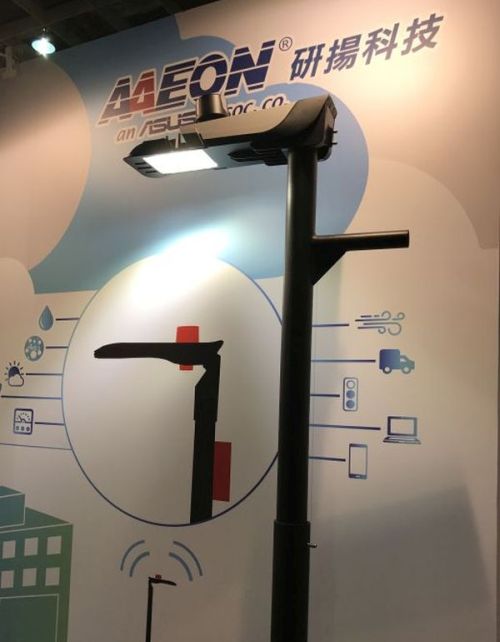At the 2017 Smart City Summit & Expo, held from February 21st to 24th in Taipei, Taiwan, companies from home and abroad showcased their diversified solutions to facilitate smart cities and IoT development. Among them, smart street lighting especially caught LEDinside’s attention.
Street lights are everywhere in cities and are essential elements to our everyday life. LEDs, in particular, with shorter switching time and energy efficiency, are an ideal light sources for street lights. By connecting
LED street lights to an intelligent management system, a smart lighting ecosystem is built and can serve as a catalyst for smart cites.
LEDinside’s latest report shows that with the support from local and central governments, the number of LED street light replacement projects has increased rapidly. In 2017, global LED street light output value is estimated to be USD 3.295 billion, with Europe and North America being the top two regional markets. In addition, from 2016 to 2018, the compound annual growth rate for LED street light shipments worldwide is expected to be as high as 20%.
In the following show report, LEDinside introduces various smart street lighting solutions at the 2017 Smart City Expo.

Chunghwa Telecom demonstrated its iGEM Smart Street Lighting Management System. With it, competent authority can remotely turn lights on and off, raise or dim, and pre schedule an on/off timetable. In addition, the sensor on each light pole can provide real-time data including temperature, wind direction, and air quality. The system has been tested in Hsinchu County, Taiwan.
AAEON Technology showcased its Smart Street Lighting System, which connects lights via a wireless network. The system provides time-based scheduling, lighting control and electricity consumption monitoring to achieve energy efficiency.

Scientech, a local provider of smart lighting and IoT solutions, exhibited its intelligent street lighting system that utilizes Acer’s BYOC cloud strategy. With sensing technology, street lights will automatically turn on when vehicles and pedestrians pass by and dim down when there is no traffic. This approach is aimed at avoiding unnecessary energy consumption.
In addition, street lights will automatically reduce light output when temperature is too high, which can extend the life of light bulbs. Furthermore, competent authority can remotely schedule repairs and repair personnel will complete repairs in one trip, which can help reduce maintenance costs.

IPSecures Corporation’s system boosts a user-friendly, cloud-based platform that allows competent authority to easily manage street lights and sensors. The system uses Google Maps as GIS and monitors street light status in a designated area.
The system also provides motion and noise sensing. For example, if the sensor on a light pole detects screaming, the system will instantly report to the nearest police station and provide real-time surveillance video.
In addition, the smart street lights can guide drivers to the nearest parking space. Notification will be sent to their phones or laptops. The company said it will put the system through a trial run by the end of 2017 in Neihu District, Taipei.
Billion Electric, a specialist in the developments of networking and energy management technologies, showcased its Street Light Control and Management System (LCMS). It combines 3G and 4G LTE broadband powerline communication as well as the company’s cloud computing platform. The system can monitor status of each street light, schedule on/off timetable, and each street light can be a security and surveillance point.
A major advantage is the system can be integrated into existing street lights from any manufacturer, both conventional and LED. On the contrary, solutions provided by its competitors require installation of new
LED lighting fixtures. Thus, the adoption cost of LCMS is relatively lower.
This time, Philips Lighting of the Netherlands also exhibited its CityTouch solution. After installing a connector node on top of any existing street light, it connects to the cloud system via the existing mobile network. Competent authority can easily adjust the brightness and measure the energy usage of single light or groups of light points.
CityTouch provides automatic failure notifications, and maintenance personnel need to document every maintenance job after it is completed. This workflow ensures lights are repaired efficiently.
Views from LEDinside
At the Expo, some Taiwanese companies demonstrated energy-saving solutions that switch street lights on when detecting vehicle or human movement and switch them off when there is no traffic. However, Philips Lighting’s CityTouch does not have this function. The company believes that security should be the top priority, so street lights will not be switched off automatically. Instead, in quieter parts of a city or places that do not require lights to be switched on full, local authority can dim illumination through CityTouch.
Dolly Tu, End User Marketing Manager of Phillips Lighting Taiwan, told LEDinside that the company’s LED bulbs are highly energy-efficient, so CityTouch will not consume more energy compared to competing solutions.
Moreover, although cases in LA and other cities show that CityTouch can work with any existing street light without the need to purchase new lights, Tu said in Taiwan, a complete replacement is still needed to implement this solution.
LEDinside concluded that when developing smart cities, there are different factors that need to be taken into consideration such as budgets, policies and different types of demand. However, since smart lighting has become an unstoppable trend, rapid LED street light adoption is expected to continue in cities around the world, which is something worth paying attention to.
















